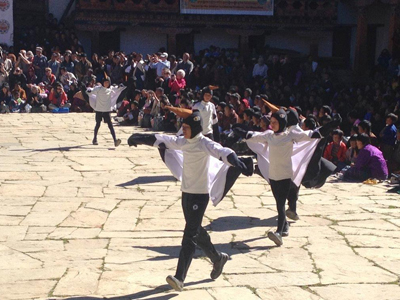 This update is reprinted from the February 2014 issue of The ICF Bugle
This update is reprinted from the February 2014 issue of The ICF Bugle
Inspiring Conservation Through the Connection Between People and Cranes
Midway along our journey from New Delhi to Bharatpur, we pulled our bus off the highway and leapt out to scan for birds and other things that might flash in our binoculars and cameras. At first glance, these intensively farmed lands, flush with people everywhere, didn’t seem a good prospect for wildlife viewing. But as the small wetlands dotting this landscape came deeper into focus, species after species appeared — a wealth of ducks, cormorants, ibises, spoonbills, storks, herons, kingfishers, and shorebirds. A herd of seven Nilgai, the largest antelope in Asia, grazed peacefully on an adjacent pasture. And then, as if following some cosmic cue, a pair of Sarus Cranes flew in and landed, with an enchanting little dance, in the center of our scene. Welcome to the SarusScape!
This fall I had the pleasure of guiding a terrific group of ICF members and supporters on a tour of Bhutan and India to share in the remarkable cultural connections between people and cranes. Bhutan, best known as the small Himalayan kingdom where “Gross National Happiness” is the measure of prosperity, is winter home to about 500 Black-necked Cranes. Every year in November since 1998, when ICF helped start a new tradition, the Bhutanese celebrate the return of their cranes from breeding grounds in Tibet with a colorful festival on temple grounds that overlook the crane landscape below. Adorned in crane costumes, Bhutanese school children of all ages celebrate the life of cranes through song, dance, and drama. We laughed as young boys — in one of those universal experiences that transcend all cultures — blushed through crane dances with their graceful female counterparts. The temple walls were lined with children’s paintings, each depicting the importance of protecting cranes, and the great benefits — healthy water, healthy wetlands, healthy communities — that come with that protection. In a country that may be as pristine as any found on this earth, the elegant cranes are a poignant symbol for preserving sacred places.

It was hard to imagine a starker contrast when our intrepid group of craniacs traveled from Bhutan to India, often described as an “assault on the senses” for its exotic flavors and colors, prostrating Sadhus, and increasingly, its pollution. But the passion for cranes, and their importance for landscape-level conservation, is every bit as powerful in India, and the stakes are much higher. The SarusScape — home to the world’s stronghold of threatened Sarus Cranes — supports some of the richest biodiversity and highest human densities of any agricultural landscape in the world. ICF SarusScape Director, Dr. K.S. Gopi Sundar, is working with local communities to safeguard traditional agricultural practices and village uses of wetlands that sustain many resident and migratory birds as a key part of a regional conservation strategy (learn more about our work in the Upper Ganges River basin). Sarus Cranes, venerated in Hindu culture much as their Black-necked cousins are in the Buddhist culture of Bhutan, are the flagship species for these small wetlands. The strong desire to save Sarus Cranes in this landscape presents a wonderful opportunity to trace the public mind from the cranes to their wetlands to the watersheds that sustain them both.
As a small conservation organization with a global mission, we often face the challenge of deciding how best to prioritize and invest scarce conservation dollars for threatened cranes. Our trip showcased those diverse opportunities — preserving unspoiled wetlands of Bhutan, or managing the rich agricultural wetlands of India. Both reap great rewards. I hope you will join us on a future trip to explore the deep cultural bonds between people and cranes, and the great acts they inspire!
